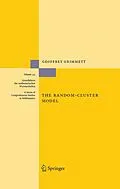The random-cluster model has emerged in recent years as a key tool in the mathematical study of ferromagnetism. It may be viewed as an extension of percolation to include Ising and Potts models, and its analysis is a mix of arguments from probability and geometry. This systematic study includes accounts of the subcritical and supercritical phases, together with clear statements of important open problems. There is an extensive treatment of the first-order (discontinuous) phase transition, as well as a chapter devoted to applications of the random-cluster method to other models of statistical physics.
Autorentext
PhD (Oxford 1974) under supervision of John Hammersley and Dominic Welsh. Member of the Mathematics Department of Bristol University (1976-1992), and subsequently appointed to the Professorship of Mathematics Statistics at Cambridge University. Author of around 100 articles and five books in probability and related fields, including Percolation (Springer 1999), Probability and Random Processes (with David Stirzaker, Oxford University Press 2001). Managing Editor of "Probability Theory and Related Fields", 2001-2005.
Zusammenfassung
Therandom-clustermodelwasinventedbyCees[Kees]FortuinandPietKasteleyn around 1969 as a uni?cation of percolation, Ising, and Potts models, and as an extrapolation of electrical networks. Their original motivation was to harmonize the series and parallel laws satis?ed by such systems. In so doing, they initiated a study in stochastic geometry which has exhibited beautiful structure in its own right, and which has become a central tool in the pursuit of one of the oldest challenges of classical statistical mechanics, namely to model and analyse the ferromagnet and especially its phase transition. The importance of the model for probability and statistical mechanics was not fully recognized until the late 1980s. There are two reasons for this period of dormancy. Although the early publications of 19691972 contained many of the basic properties of the model, the emphasis placed there upon combinatorial aspects may have obscured its potential for applications. In addition, many of the geometrical arguments necessary for studying the model were not known prior to 1980, but were developed during the 'decade of percolation' that began 1 then. In 1980 was published the proof that p = for bond percolation on the c 2 square lattice, and this was followed soon by Harry Kesten's monograph on t- dimensionalpercolation. Percolationmovedintohigherdimensionsaround1986, and many of the mathematical issues of the day were resolved by 1989. Interest in the random-cluster model as a tool for studying the Ising/Potts models was rekindled around 1987.
Inhalt
Random-Cluster Measures.- Monotonic Measures.- Fundamental Properties.- Infinite-Volume Measures.- Phase Transition.- In Two Dimensions.- Duality in Higher Dimensions.- Dynamics of Random-Cluster Models.- Flows in Poisson Graphs.- On Other Graphs.- Graphical Methods for Spin Systems.
